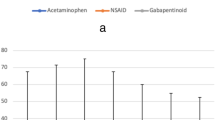Abstract
Purpose
The purpose of this study is to determine the possible correlation between the do-not-resuscitate (DNR) status and the prescribed use of systemic strong opioid analgesics (SSOA) among patients with terminal cancer in Taiwan.
Methods
This retrospective cross-sectional study used data from a single tertiary care medical center. We identified patients with terminal cancer who died after signing a DNR order between 2008 and 2016. Subsequently, we reviewed their clinical characteristics, DNR consent type, survival time after DNR declaration, and SSOA dose.
Results
Of the 4123 patients enrolled for this study, 1380 (33.5%) had received SSOA before DNR and 2742 (66.5%) had received SSOA after DNR (p < 0.001). SSOA doses administered after the DNR order were significantly higher than those administered before the DNR order (median, 78 vs. 60 mg, p < 0.01).
Conclusion
Patients’ DNR status likely influenced physician decision in prescribing SSOA. However, additional studies are necessary to clarify the factors that influence the decision-making of physicians regarding SSOA prescription.


Similar content being viewed by others
References
Ministry of Health and Welfare (2018) Causes of deaths statistics. https://www.mohw.gov.tw/np-128-2.html. Accessed 16 February 2019
van den Beuken-van Everdingen MH, de Rijke JM, Kessels AG, Schouten HC, van Kleef M, Patijn J (2007) High prevalence of pain in patients with cancer in a large population-based study in the Netherlands. Pain 132:312–320
van den Beuken-van Everdingen MH, De Rijke JM, Kessels AG, Schouten HC, van Kleef M, Patijn J (2007) Prevalence of pain in patients with cancer: a systematic review of the past 40 years. Ann Oncol 18:1437–1449
Ripamonti CI, Santini D, Maranzano E, Berti M, Roila F, ESMO Guidelines Working Group (2012) Management of cancer pain: ESMO clinical practice guidelines. Ann Oncol 23:vii139–vii154
Chen RC, Chung DCH, Lai EYL, Chao CCS (2001) The development of hospice palliative care in Taiwan. Taiwan J Hosp Palliat Care 61:2–13
Lopez-Saca JM, Guzman JL, Centeno C (2013) A systematic review of the influence of opioids on advanced cancer patient survival. Curr Opin Support Palliat Care 7:424–430
Bercovitch M, Waller A, Adunsky A (1999) High dose morphine use in the hospice setting: a database survey of patient characteristics and effect on life expectancy. Cancer 86:871–877
Morita T, Ichiki T, Tsunoda J, Inoue S, Chihara S (1998) A prospective study on the dying process in terminally ill cancer patients. Am J Hosp Palliat Care 15:217–222
Morita T, Tsunoda J, Inoue S, Chihara S (2001) Effects of high dose opioids and sedatives on survival in terminally ill cancer patients. J Pain Symptom Manag 21:282–289
Thorns A, Sykes N (2000) Opioid use in the last week of life and implications for end of life decision-making. Lancet 356:398–399
Regnard C, Badger C (1987) Opioids, sleep and the time of death. Palliat Med 1:107–110
Sykes N, Thorns A (2003) The use of opioids and sedatives at the end of life. Lancet Oncol 4:312–318
Eastern Metropolitan Region Palliative Care Consortium (Victoria) (2016) Opioid conversion ratios-guide to palliative care practice. http://www.emrpcc.org.au. Accessed 26 February 2019
Meier EA, Gallegos JV, Thomas LP, Depp CA, Irwin SA, Jeste DV (2016) Defining a good death (successful dying); literature review and a call for research and public dialogue. Am J Geriatric Psychiatry 24:261–271
Mystakidou K, Tsilika E, Kouloulias V, Parpa E, Katsouda E, Kouvaris J, Vlahos L (2004) The “Palliative Care Quality of Life Instrument (PQLI)” in terminal cancer patients. Health Qual Life Outcomes 2:8
Chau DL, Walker V, Pai L, Cho LM (2008) Opiates and elderly: use and side effects. Clin Interv Aging 3:273–278
Daoust R, Paquet J, Moore L, Émond M, Gosselin S, Lavigne G, Choinière M, Boulanger A, Mac-Thiong JM, Chauny JM (2018) Recent opioid use and fall-related injury among older patients with trauma. CMAJ 190:E500–E506
Foley KM (2004) Treatment of cancer-related pain. J Natl Cancer Inst Monogr 32:103–104
Falk S, Dickerson AH (2014) Pain and nociception: mechanisms of cancer-induced bone pain. J Clin Oncology 32:1647–1654
American Cancer Society (2007) Cancer facts and figures. Atlanta: American Cancer Society. https://www.cancer.org/content/dam/cancer-org/research/cancer-facts-and-statistics/annual-cancer-facts-and-figures/2007/cancer-facts-and-figures-2007.pdf. Accessed 26 February 2019
Coleman RE (2001) Metastatic bone disease: clinical features, pathophysiology and treatment strategies. Cancer Treat Rev 27:165–176
Acknowledgements
The authors would like to thank the Clinical Informatics Research and Development Center, Cancer Registry database, and Biostatistics Task Force of Taichung Veterans General Hospital for administrative assistance.
Author information
Authors and Affiliations
Corresponding author
Ethics declarations
The study protocol was approved by the Institutional Review Board (IRB) of Taichung Veterans General Hospital (IRB number CE18043B).
Conflict of interest
The authors declare that they have no conflicts of interest.
Disclaimer
The interpretation and conclusions contained herein do not represent those of Taichung Veterans General Hospital.
Additional information
Publisher’s note
Springer Nature remains neutral with regard to jurisdictional claims in published maps and institutional affiliations.
Electronic supplementary material
Supplementary Table 1
(DOCX 15 kb)
Rights and permissions
About this article
Cite this article
Wang, CL., Lin, CY., Huang, CC. et al. Do-not-resuscitate status is correlated with the prescribed use of systemic strong opioid analgesics in patients with terminal cancer: an observational study. Support Care Cancer 27, 4507–4513 (2019). https://doi.org/10.1007/s00520-019-04765-6
Received:
Accepted:
Published:
Issue Date:
DOI: https://doi.org/10.1007/s00520-019-04765-6




